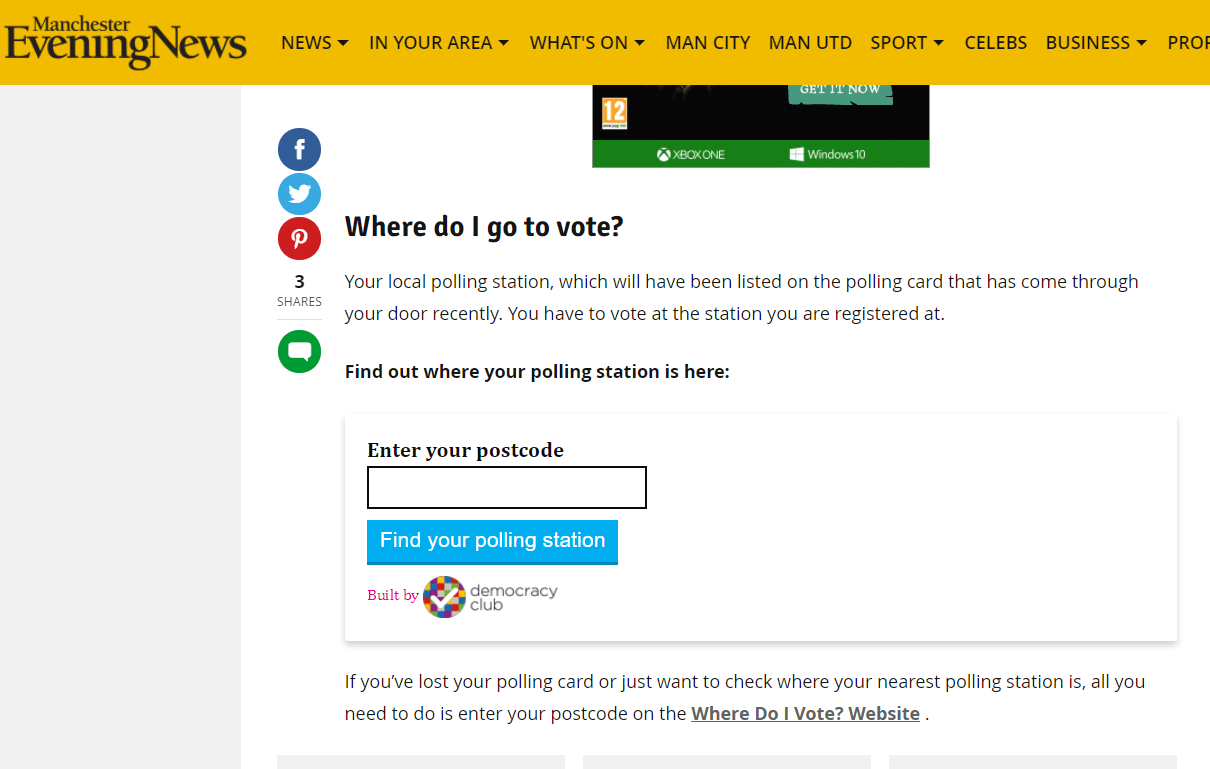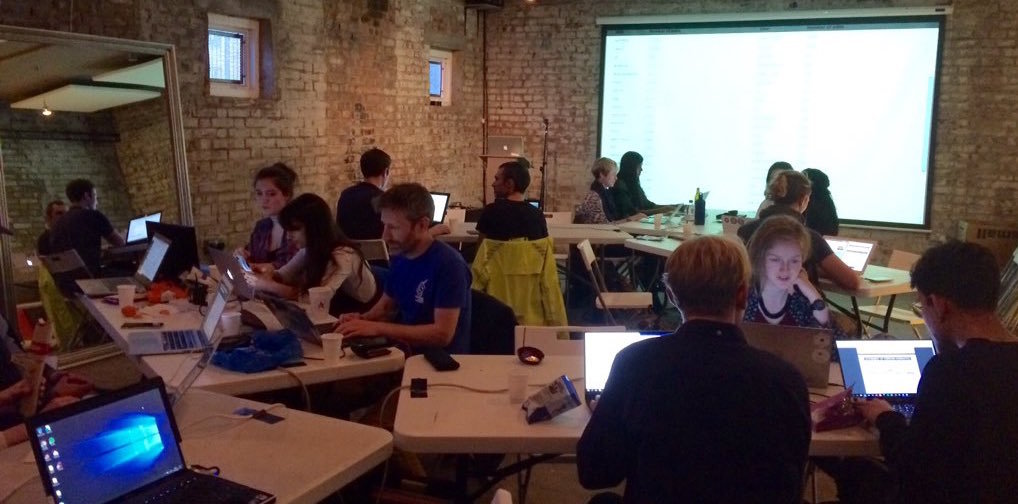Towards better elections
Report on Democracy Club’s work on the 2017 elections and the future of digital services for democracy

This report is a work in progress, you can comment on the Google Documents version of it.
Democracy Club’s vision is of a society in which democracy thrives through knowledge, participation and openness. Our mission is to use open data, design and technology to give every citizen the information and participation opportunities they need, in a way that suits them.
We are non-partisan and we work openly. We’re a community of 12,000 club members and a small core team.
We don’t have a view of ‘the perfect democracy’. Instead, we try to make constant iterative improvements based on citizens’ needs. We judge those needs based on publicly available research, feedback on our websites and online search data.
This report covers our 2017/2018 ‘election year’. This is covers the 11 months after the 2017 general election up to and including the local elections on 3 May 2018. It aims to explain the effects of the club’s work.
Summary
This year, we:
- Had polling location data for 87% of the 18+ population at the May elections
- Served 340,000 polling locations
- Crowdsourced basic details of over 16,000 candidates
- Served 489,000 candidate lookups
- Developed systems to record by-elections and their candidates
- Ran well-attended events in London, Birmingham and Manchester to crowdsource candidate data
- Created the conditions for two new organisations to use our data to encourage pre-election engagement between candidates and voters
This year may have marked the point at which the work we do became ‘normal’. Electoral officers knew to send their polling station data to us, local political parties knew that we’d be collecting candidate information, and media owners or journalists knew that we would be able to provide access to election-related data.
The coverage and use of our products and data was generally greater than at any other set of scheduled local elections we have worked on. This is our third set of scheduled local elections and the only set not to be followed by a referendum or general election.
The task remains to expand our capacity so we can deliver on the many and varied ideas we have and that are submitted to us, to keep improving voters’ experience of elections and to bring our approach to new areas of democratic engagement beyond elections.
Thanks, as always, to hundreds of volunteers who put in the time to make this all possible as well as funders, supporters and advocates of the work.
This report largely covers the levels of use of our tools and services. We are not yet able to show our impact in terms of cognitive or behavioural change, such as enhanced trust in democracy or increased participation rates. It is difficult to measure these outcomes, let alone prove that they were caused by our work, but we aspire to better understand these in future.
Moreover, we are yet to precisely define the social outcomes we are trying to achieve. Should we seek to improve turnout, knowledge, trust, community or a combination of these? Over the next year, we will aim to establish the desired outcomes for our work with the assistance of the board, club members and anyone else who has a view. You are warmly invited to contribute — contact details below!
Joe Mitchell, Sym Roe and Chris Shaw
The year in data

Elections data
Coverage
We began our attempt to systematically record by-elections following the last general election. Between 8 June 2017 and 3 May 2018 we recorded hundreds of by-elections across district, county and unitary councils, combined authorities, devolved assemblies and the UK Parliament. We are aware that we missed a small number of by-elections over the summer and autumn of 2017, but are confident that since early 2018 we have been recording them all.
For 3 May 2018, we recorded scheduled elections for six mayors, 4,380 councillor posts in 2,753 wards.
Also for 3 May, we also covered the details voter ID ‘pilots’ that took place this May in five local authorities in collaboration with the Cabinet Office. We researched the requirements of each authority (they each differed) and added this information to the elections data.
Partners
There were no partners who used the elections data.
Reach/use
This dataset was used every time a postcode lookup was made via a Democracy Club service — that is, 1.1m times for the 3 May elections.
Analysis
Our ability to cover all elections, with more notice, is due to at least two factors. In previous years, much of this work involved freedom of information requests and internal lobbying in order to access the critical boundary data (i.e. so we know where the election is happening). We are delighted that since last year’s report, the Local Government Boundary Commission for England (LGBCE) has started publishing their data under an Open Government Licence in a timely way. This, plus our internal improvements for tracking ‘Electoral Change Orders’ has meant we are able to add elections to our sites much earlier in the electoral cycle.
Unfortunately, official Government Statistical Service (GSS) codes for the areas with new boundaries are not published until after elections take place. We hope to work with the Official for National Statistics (owner of the GSS codes) and LGBCE over the next year to find a better solution to publishing identifiers for newly created boundaries in a way that’s useful for covering elections.
Evidence from user feedback, use of the API and from Google AdWords search keywords, suggests that significant numbers of people did not know whether they had an election on 3 May. Our websites and Your Vote Matters (the Electoral Commission’s voter information website) provided an answer, but we might think harder about how to partner with more organisations to use the elections data. For example, in May 2016, Buzzfeed ran an ‘election-checker’ service on their homepage, perhaps this could have been reactivated.
Other user feedback suggested it may have been helpful to attach ‘election explainers’ to the data to help people understand what they are voting for. This demand for explanation appears more commonly at local elections than general elections.
Lastly, our elections data is now robust and high quality enough to allow for development of a nationwide reminders service.
Candidates data
Coverage
We recorded candidates data for every scheduled election and by-election on 3 May 2018, totalling 16,106 candidates. We also collected candidate data for every by-election we knew about outside 3 May 2018, totalling 1,231 candidates1.
For the May 2018 elections, we recorded at least one contact detail (any social media presence or email address) for 23.5% of the candidates. We had statements (text from the candidate explaining why voters should give them their vote) for 8% of candidates and a photo of 14.7% of candidates.
Partners
The following organisations used the candidates data: The Electoral Commission via their Your Vote Matters website We Own It, a campaign group, used it to encourage their supporters to email their candidates End Empty Homes, a campaign group, used it to encourage candidate pledges
Previous partnerships with Facebook and Google did not recur for the local elections. Both organisations have told us that they are unlikely to activate any election-related tools for anything other than general elections.
Reach/use
The candidates data was used 489,000 times via the API. The data will have been used an unknown additional number of times via third parties who downloaded the candidates data via a link on the website. CSV files of candidate data were downloaded over 27,000 times, but only a small number of these downloads will have been by people using the data, as opposed to automated programs.
Analysis
Each year, Democracy Club volunteers do extraordinary work converting thousands of PDFs ever more quickly into useful structured open data on candidates. For the local elections this year we expanded our crowdsourcing parties, running events in London, Manchester and Birmingham, because each city had ‘all-up’ every seat elections. These events, plus some amazing individual efforts meant that we had a complete list of candidates and their party affiliation within ten days of the official nomination papers’ publication.
While our coverage of candidates names and party affiliation remains excellent, we are still unable to create the depth of information that voters request. This is sometimes because local candidates do not have any online presence, but may also be down to the limits of crowdsourcing. The 8% of candidates with statements compares poorly to the 34% for the general election, but slightly better than the 2017 local elections.
We will continue to investigate the potential for automating more of the data collection process, perhaps by working with local authorities or electoral management software suppliers on the names and party affiliations. This year we also launched a machine-learning challenge to see whether automation was possible even without any changes to the current process. Any automation would free up volunteer time to boost the depth of candidate information.
Another approach to improving the quality or depth of the candidates information is to go via political parties. We have long presumed that political parties have an interest in ensuring that their candidate information is online and thus that they will be instrumental in adding candidate data. This has not always proven true. However, at the local elections, several chairs of local parties across the political spectrum came forward to offer their own datasets (spreadsheets), complete with contact details for their local candidates. They were not willing to enter the information on an individual-by-individual basis due to time constraints, but were happy for us to upload their information into our database. We do not currently have the functionality to take advantage of this, but it seems this should be a priority for 2018-2019.
Polling locations data
Coverage
We were able to provide users in 126 of the 152 local authorities with scheduled elections with their polling location. That means we covered 87% of the 18+ population in areas with a scheduled election, up from 61% at the 2017 general election.
Partners
The data was used by: The Electoral Commission’s Your Vote Matters website, the Labour Party, and Democratic Dashboard (a project from the London School of Economics / Democratic Audit).
Reach/use
There were 615,995 searches for polling locations at the May elections. These were mostly served by partners via our API.
| Total | Website | API | Embed | |
|---|---|---|---|---|
| Searches | 615,995 | 72,920 | 514,462 | 28,613 |
| Found | 340,384 | 56,206 | 259,141 | 25,037 |
| % Found | 55.26% | 77.08% | 50.37% | 87.50% |
The relatively high numbers of searches ‘not found’, given that we had 87% coverage, suggests that a lot of people in areas without elections tried to use the finder. If we filter the above data to only the 152 areas with scheduled elections:
| Total | Website | API | Embed | |
|---|---|---|---|---|
| Searches | 388,755 | 61,744 | 300,358 | 26,653 |
| Found | 340,384 | 56,206 | 259,141 | 25,037 |
| % Found | 87.56% | 91.03% | 86.28% | 93.94% |
We have separately published a table with the numbers of searches per local authority area.
Analysis
This year represents a significant step forward in coverage for the polling location data. We had feared that councils might have been less likely to provide data for a less popular election. In fact, the coverage level suggests that the finder is now a known, trusted product and providing data is on the ‘election to-do list’ for electoral officers.
We will continue to work with the local authorities and their software suppliers to improve the process and expand the coverage for the 2019 elections.
Results data
Coverage
In a first for Democracy Club, volunteers managed to collect the vote count for every candidate at the scheduled elections in May. Where possible, volunteers also collected turnout data, but because this is not statutorily required, many councils do not publish it or there are differences in how councils report it.
Partners / usage
Results data was used to power several data visualisations, such as Russ Garrett’s nationwide results map and Open Data Leeds’ visualisation of turnout across Leeds.
We also know of anecdotal evidence that political party activists are using the data to identify significant shifts in the vote, in order to prioritise further research or campaign efforts. We assume that all parties create their own database of election results, but the existence of open data here saves considerable time for them all.
We Own It, the campaign group who used the candidates data to encourage candidates to support their aims, are using the results data to identify those pledgers that have been elected, in order to hold them to account.
Reach/use
We do not have good data on how many people this information reached. There were 340 downloads of a table of results data, and 3,800 machine requests to an automated feed of results data, but some of these will have been our own services.
Analysis
The obvious value of open results data is to help voters to find out who won (or to allow a third-party to push a notification of the results to a voter whose postcode is known). User feedback to WhoCanIVoteFor.co.uk suggests that voters expect this information to be available overnight. Although it took several days to complete the set of results, we have made a significant step towards ‘closing the feedback loop’ for voters here.
Results data also allows us to maintain a list of winners, who become political representatives. We can use this data to potentially create new open data on local representatives, moving us a step closer to a goal we suggested last year.
We also note that better turnout data would help many organisations to understand what affects turnout. We will consider whether there is anything we can do to help make this happen.
Apps

These are the voter-facing services we provide, i.e. websites and embeddable tools (the polling location widget).
WhoCanIVoteFor.co.uk
This website allows users to enter their postcode to lookup their candidates. It was used 113,809 times by 100,100 unique users in the month up to and including 3 May.
A feedback form on the website asks whether users found what they were looking for: an average of 22% of respondents responded positively over the month. A higher percentage of users found what they were looking for as we neared election day: this could be because those searching nearer the day are less demanding or could have been a result of the increased amount of local party information we attached to candidates as we got closer to the election (see next paragraph). We aim to publish the open text box feedback in the future.
The addition of local party information, such as a twitter account, website or best, a manifesto, helped us ensure that 11,634 candidate pages (72%) had some kind of link to information on their local party. Volunteers also found over 500 local manifestos, which meant that 6,301 candidates (39%) could be linked to a manifesto, providing much richer information than before. We have not broken down the feedback to see if it made a difference, but this feels like a small step in the right direction.
For a small number of wards in London, we also displayed candidate ‘pledges’ sourced by Hope Not Hate from candidates in a small number of wards in London. We will continue to investigate whether this presents a way to provide more useful information on candidates.
Other data sources we displayed on the website included: hustings data (we crowdsourced the details of 134 events) and results data, once it had been recorded.
We had some complaints from people who had been given the wrong ward for their postcode. This is because postcodes don’t always exactly cover electoral areas, but there are more cases where it gives a wrong ward than, for example, a wrong parliamentary constituency. This is an area we hope to focus on in the next year. We also wrote about a similar issue on our blog.
WhereDoIVote.co.uk
This website allows users to find their polling location by entering their postcode and if necessary, their address. It served 49,000 unique users from Monday 30 April to Thursday 3 May 2018. Of those who completed the feedback form on the site, 96% reported that they found the site useful, up three percentage points from last year.
We made several improvements to the site based on last year’s user feedback, which seemed to positively affect the score and this year’s feedback (e.g. the move to a single-column layout appeared to help users learn about the opening hours of polling stations more easily).
Most of the negative feedback related to errors in postcodes or the map locations of the polling stations. We were able to improve the data based on this feedback.
We have published a more detailed report on the user feedback here.
Embeddable polling location finder (the widget)
Last year, a volunteer developed an embeddable polling location finder (or widget) that could be added to any website. This year, we particularly encouraged councils and news sites to use it: at least 15 councils did so, including Birmingham City Council, as well as several Trinity Mirror sites and the Evening Standard. The widget was used 25,000 times.

3 May 2018.
Labs

This is the theme of work that includes anything experimental or that goes beyond elections to look more broadly at ‘democracy’.
We had listed a range of possible projects under ‘Labs’ as part of our goals for this year. Unfortunately, the only labs idea we were able to get to was the addition of local manifestos on WhoCanIVoteFor.co.uk. The rest were beyond our capacity this year.
For 3 May elections, we lightly piloted tailored election reminder emails to those who have requested them (users of our websites can sign up to these with a postcode and email address). We divided up signees based upon how many elections they had, and which type, and sent emails based on this. The lists were relatively small, but the emails were well-received: open rates were around 50% with click-through rates varying from 11% to 27%.
ODI Registers Report
The Open Data Institute commissioned us and Open Health Care to research and produce a report on collaborative registers (our candidates lists could be understood this way). You can read it here.
One of the main findings of the report was that the governance of data is important for trust and reuse. If third parties can’t trust data sources, they are unlikely to use them. They are more likely to trust data if there are clear ways to report errors, or better still, contribute to the data directly in order to improve it. Democracy Club does this in an ad-hoc way for much of our data (e.g. members of our internal chat, Slack, can alert us to things that need fixing), or in a more formal way on our candidates site (all edits have a source, we keep each version). There is still room for improvement in explaining how our data is governed. We might be able to share some patterns for explaining governance as part of our improvement work.
Club

This section of the report covers the community elements of the work we do, and the financial and administrative status of Democracy Club.
Our mailing list currently stands at just over 12,000 people. We have 46 monthly donors and we had around 400 volunteers adding data for the 3 May elections.
In late 2017 eight new non-executive directors from a range of background joined the board, to be chaired by Alice Casey. You can read about them via this blog post.
We currently have reserves to see us through the 2019 local elections assuming no new staff hires or general elections. Our 2017/2018 funders were The Electoral Commission and Unbound Philanthropy at around £50,000 each.
What’s next?
 We will now work to set a range of goals for the next election year, have a plan in place for a snap general election
and also aim to think longer-term about our goals and our places in the civic participation ecosystem.
We will now work to set a range of goals for the next election year, have a plan in place for a snap general election
and also aim to think longer-term about our goals and our places in the civic participation ecosystem.
As the scorecard appended below shows, the goals we set for 2017/2018 were mostly achieved — if we exclude the ideas we had for Labs — which suggests we had a relatively good sense of what was realistic. However, there were elements left behind that clearly indicate the need for extra resource even in the short term: growing the community and club, research and diversity.
In terms of the longer-term, the core team has spent some time considering how to grow the club via a new fundraising effort. The effort describes how, as a first phase, we would like to expand the team to have design, research, measurement and organising capability, with the aim to increase the quality and grow the impact of what we already do. We then outline a second phase, describing the resources needed to go beyond our existing projects and products to take our approach to other elements of the democratic process that need improvement. A third, more longer term, aim is to raise money to use our knowledge to become an effective funder of democratic innovation projects in the UK.
As always, we welcome new ideas to consider or new problems to solve. We will host a summer get-together on Saturday 23 June in Manchester: please come along with any ideas, reflections or just to hang out. Alternatively you can email us, tweet us or make specific issue requests about our products via Github.
Acknowledgements
 We owe many thanks to many people. To start with, the volunteers, such as the data wombles, who spend hours clearing
up the UK’s election data mess into something everyone can use. You can see the
top editors of our crowdsourcing site
here. Other volunteers do essential work helping us keep our systems running or advising us on aspects of
electoral
arcania.
We owe many thanks to many people. To start with, the volunteers, such as the data wombles, who spend hours clearing
up the UK’s election data mess into something everyone can use. You can see the
top editors of our crowdsourcing site
here. Other volunteers do essential work helping us keep our systems running or advising us on aspects of
electoral
arcania.
Thanks to The Electoral Commission, the Association of Electoral Administrators, the Local Government Information Unit, many local authorities and other advocates that support and champion our work.
We are grateful to Unbound Philanthropy, The Electoral Commission and many individual donors for their financial support; you can join them!
Help us out!
Not yet a data womble? Interested in other plans to save democracy? Just want to follow along? Join our mailing list at democracyclub.org.uk.
Join the open Google Group to start your own email discussions here.
For more day-to-day chatter and calls for help, join our Slack.
And of course, if you are able, please also support our work with a monthly donation at democracyclub.org.uk/donate.
Scorecard of 2017-2018 goals
In June 2017 we set ourselves a range of goals. The table below reviews our progress against those goals.
| Goal | Met? | Comment |
|---|---|---|
| In the event of a general election during the year, do as we did in 2017 (or better!). | n/a | Phew. |
Data
| Goal | Met? | Comment |
|---|---|---|
| 100% of elections at district council level or above, including by-elections, identified by an election ID | Partially met | We know we missed some by-elections in the months following the general election, but believe we've had full coverage since late Autumn 2017. |
| Maintain a published list of these elections | Met | |
| Explore mechanisms to increase accuracy of notification & confirmation of election | Met? | We developed an 'election radar' tool to help automate notification and work closely with leading election-spotters to increase our accuracy |
| Goal | Met? | Comment |
|---|---|---|
| Publish names and party information for 100% of candidates in above elections | Partially met | We had at least one by-election with no candidates listed. We developed a bot to point to elections where we don't have candidates to help direct volunteer efforts. We think we're on top of this now. |
| Publish email addresses for XX% of candidates | n/a | We forgot to set ourselves a target. We had email addresses for 17.5% of candidates for 3 May |
| Publish at least one social media profile for XX% of candidates | n/a | We also forgot to set a target here, but 12.7% had a twitter; 23.6% candidates had at least one contact detail |
| Goal | Met? | Comment |
|---|---|---|
| Publish polling location data for 75% of councils with elections in May 2018 | Met | 83% of councils (or 87% coverage of the 18+ population in areas with elections) |
| Publish polling location data for 100% of the 32 London boroughs, Birmingham and Manchester | Nearly met | Missed one London borough due to technical issues |
| Goal | Met? | Comment |
|---|---|---|
| Publish winning candidate data and vote count for 100% of results at May 2018 elections | Met | Astounding! |
| Goal | Met? | Comment |
|---|---|---|
| Run improved Where Do I Vote? service | Met | We made improvements based on 2017 user feedback. 96% users found what they were looking for (three-point improvement on 2017) |
| Run improved Who Can I Vote For? service | Unknown | We don't have the satisfaction score for Who last year |
| Full set of statements from candidates in 20 marginal London borough wards for May 2018 | Not met | We lacked capacity to chase individual candidates here |
| Find support for ElectionLeaflets.org (talk to five academic, cultural or heritage institutions and media companies) or close it down | Not met | Chats with academics, reached out to museums, no chance of financial support, need to shut it down |
| Goal | Met? | Comment |
|---|---|---|
| Help 250,000 people engage with election information across Data and Apps | Met | 1.1m total hits to the APIs (NB. This includes repeat uses by the same person.) |
| Greater percentage of users find Who and Where useful (vs 2016 previous comparable elections) | Partially met | 96% on Where (up from 93.5% last year); 22% on Who (unknown in 2017) |
| Users on Who Can I Vote For? spend long enough on the pages to read the information | Partially met | The average user spent two-and-a-half minutes on the site in the week running up to 3 May. |
Club
| Goal | Met? | Comment |
|---|---|---|
| New board of directors | Met | News in this report |
| Goal | Met? | Comment |
|---|---|---|
| Raise £150,000 of new funding beyond existing committed funds | Not met | We've had a lot of chats, but nothing committed yet |
| Make sales to local authorities or Cabinet Office | Not met | We met the Cabinet Office, but it's unclear as to whether they could fund; local authorities responses varied, but did not seem promising (yet) |
| Test new approaches to individual member donations | Not started |
| Goal | Met? | Comment |
|---|---|---|
| Publish weekly blog | Partially met | |
| Send monthly newsletter | Partially met | |
| Plan clear onboarding process | Not met |
| Goal | Met? | Comment |
|---|---|---|
| Make effort to understand diversity of members, partners and end users | Not met | We were offered some help here but that fell through â we need to pursue this harder |
| Goal | Met? | Comment |
|---|---|---|
| Understand best practices through meeting with three well-regarded organisations | Not started | Ditto |
| Publish a code of conduct | Met | Read it here |
| Design appropriate approach for the club [to improve its diversity] | Not started |
| Goal | Met? | Comment |
|---|---|---|
| Write research plan to cover end users and partner organisations | Partially met | Several volunteers helped us begin to design this work, but time ran out |
| React to research discoveries with new approach or prototype products | Not started |
| Goal | Met? | Comment |
|---|---|---|
| Plan for personal development for staff | Not started |
| Goal | Met? | Comment |
|---|---|---|
| Start work on open historical results database | Not started | |
| Ensure 50% of May 2018 candidate pages on Who Can I Vote For? are linked to local manifestos | Not met | Over 6,000 candidate pages linked to a local manifesto, but this represented only 39% of all candidates. Over 11,000 candidates (72%) could be linked to at least one piece of information on a local party, which is a step forward. |
| Goal | Met? | Comment |
|---|---|---|
| Begin work on the UK representatives database | Not started | |
| Do something offline, potentially | ||
| London 2018 candidate debates in 20 wards | Not started | |
| Tools for door-to-door organising (could be awareness, issues, registration, GOTV) | Not started | |
| Member-organised meetups | Not started | |
| Win new project grant to review UK civic education and design proposal for moonshot project | Not started |
-
These numbers may include some double-counting if candidates stood in more than one election over this period. ↩